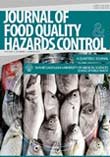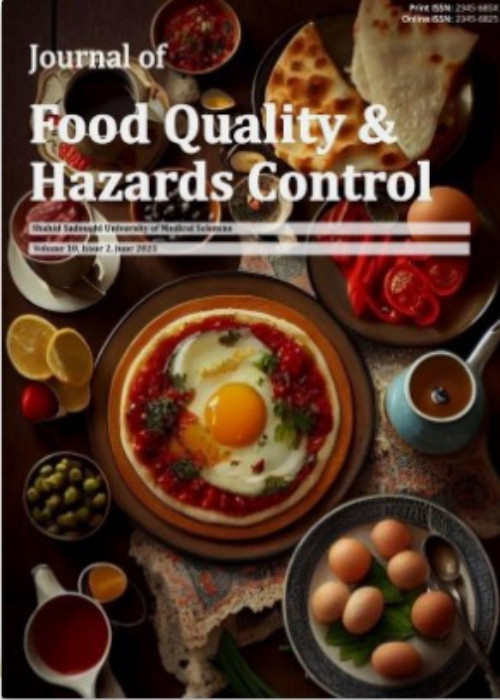فهرست مطالب

Journal of Food Quality and Hazards Control
Volume:4 Issue: 1, Mar 2017
- تاریخ انتشار: 1396/02/02
- تعداد عناوین: 8
-
-
Pages 3-8BackgroundInnovative bioactive films incorporated with antimicrobial agents have been recently developed for food preservation. The aim of this study was to evaluate antibacterial activity of Polylactic Acid (PLA) films incorporated with Ziziphora clinopodioides Essential Oil (ZEO) and Ethanolic Propolis Extract (EPE) against some common food-borne pathogens.MethodsThe volatile chemical compounds of ZEO were identified by analytical gas chromatography. Different PLA film groups were prepared using ZEO (1% and 2%) and EPE (1% and 2%), separately and in combination. Disk diffusion method was used in order to evaluate antibacterial activity of experimental groups. The analysis was performed using SPSS 16.0.ResultsThe PLA films enriched with the ZEO possess better antibacterial activity compared to the films incorporated with EPE (pListera monocytogenes>Bacillus subtilis>B. cereus>Salmonella entritidis serovar Typhimurium>Escherichia coli O157:H7. The combination of ZEO and EPE showed significantly higher antibacterial effects against all bacteria than those of obtained with each single ZEO or EPE (pConclusionThe PLA films incorporated with ZEO and EPE had considerable antibacterial activity, indicating potential of these films for application as active packaging in food industry.Keywords: Poly (lactide), Oils Volatile, Propolis, Anti, Bacterial Agents
-
Pages 9-13BackgroundEscherichia coli is one of the most important pathogens which could be transmitted by milk. The main aim of the present study was to assess risk factors related to the occurrence of E. coli in fluid milk marketed in Chittagong, Bangladesh.MethodsTotally, 169 milk samples were collected from different entry points in Chittagong, Bangladesh; and also, 17 samples were directly collected from a dairy farm. The milk samples were microbiologically analyzed for detection of E. coli. A questionnaire was designed and then administered by two trained veterinarians who interviewed milk vendors at time of milk collecting. The data were analyzed by Stata 11 (Stata Corp, College Station, Texas, USA).ResultsE. coli was found in 18.3% and 11.8% milk samples obtained from markets and dairy farm, respectively. The results of univariable analysis showed that addition of water hyacinth leaves to milk had the strongest point estimate of effect Odds Ratio (OR 27.1) and high statistical significance (p=0.0007) despite wide 95% Confidence Intervals (CIs) of 2.8-1291.6. The final logistic regression model identified two variables as independent risk factors for the presence of E. coli in fluid milk including selling milk after 1-2 h of collection (OR 4.7, 95% CI 1.9-11.7), and also adding banana tree leaves into milk (OR 3.8, 95% CI 1.5-9.4). The final model identified washing milk vat/container everyday with tube well water (OR 0.1, 95% CI 0.050.3), as a protective factor.ConclusionThe two main factors with great influence on risk of E. coli in fluid milk marketed in Chittagong, Bangladesh consisted of selling milk after 1-2 h of collection and also adding banana tree leaves into milk. Educational awareness should be highlighted to inform consumers and farmers in this regard.Keywords: Risk Factors, Escherichia coli, Milk, Bangladesh
-
Pages 14-19BackgroundFillet is a popular part of chicken carcass which its high perishability is an economic problem. The present research was designed to study the microbial, chemical, and sensorial properties of chicken fillets coated by gelatin-Carboxymethyl Cellulose (CMC) film containing Essential Oil (EO) of Bene (Pistacia atlantica).MethodsThe chicken fillets were coated by gelatin-CMC film containing 0.3, 0.6, and 0.8% concentrations of Bene EO. Different microbial and chemical analyses were carried out at different intervals (days 0, 3, 6, 9, and 12). Data were analyzed using SPSS, Inc, Chicago, IL software (v. 18.0).ResultsAerobic mesophylic bacteria, psychotropic bacteria, lactic acid bacteria, and coliform counts in Bene EO treated groups were significantly (p0.05), bacterial growth was significantly (p0.05) between thiobarbituric acid, total volatile nitrogen, and peroxide values in control and 0.3% Bene EO treated chicken fillet groups; however, these chemical parameters were significantly (p0.05). Although no changes in color and texture of samples treated by 0.6% and 0.8% Bene EO were seen, but there was a slight decline in odor and taste scores.ConclusionChicken fillets coated by gelatin-CMC film containing 0.6% Bene EO showed acceptable antibacterial, antioxidant, and sensorial properties. So, the outcome of the present work can be applied in the meat industries.Keywords: Meat, Oils Volatile, Antioxidants, Anti, Bacterial Agents
-
Pages 20-23BackgroundEnterococcus spp., belonging to the group of lactic acid bacteria, are Gram-positive ubiquitous commensals of the intestines of human beings as well as warm-blooded animals. The main objective of this study was to determine the occurrence and antimicrobial resistance of Enterococcus spp. isolated from lettuce and irrigation water in Abidjan, Côte dIvoire.MethodsA total of 72 samples, including leaves of lettuce (n=36) and irrigation water (n=36) were randomly collected from three different agricultural sites located in Abidjan city, Côte dIvoire. After microbial analysis and identification of Enterococcus spp. by culturing and biochemical methods, antimicrobial susceptibility tests were carried out using disk diffusion method. Data were analyzed by statistical processing software R (R 3.0 for Windows).ResultsE. faecalis was recognized as the most prevalent strain which was found in 27 out of 36 (75%) lettuce as well as 29 out of 36 (80.5%) irrigation water samples. The mean Enterococcus load of lettuces and irrigation water samples were 2.3±0.7 and 3.6±2 log Colony Forming Unit per g lettuce, respectively. Among 45 studied enterococci isolates, the most antibiotic-resistance rates were related to erythromycin (54%) and also co-trimoxazole (49%).ConclusionThere is a considerable public health concern regarding raw consumption of lettuce cultivated in Abidjan city which can cause gastroenteritis diseases in consumers.Keywords: Enterococcus, Lettuce, Water, Drug Resistance Microbial
-
Pages 24-28BackgroundEscherichia coli O157:H7 is a Gram-negative and facultative anaerobic food-borne bacterial pathogen. The major purpose of this study was to evaluate physicochemical characteristics of nanoliposome garlic Essential Oil (EO) and its antibacterial effect on E. coli O157:H7.MethodsNanoliposome garlic EO was prepared by ethanol injection method and its physicochemical properties were evaluated. After inoculation of E. coli O157:H7 to experimental groups, minimum inhibitory concentration and minimum bactericidal concentration were assessed. Data were analyzed using SPSS software (version 16.0).ResultsThe average particle sizes of prepared nanoliposomes were 131.73±14.31 nm with a polydispersity index of 0.212±0.013. The percentage of liposome permeability after 5, 10, 30, and 50 days were 0.46%, 2.47%, 5.63%, as well as 7.29%, respectively, revealing significant difference (pConclusionNanoliposome encapsulated garlic EO showed enhancing antimicrobial activity against E. coli O157:H7 in comparison with the non-encapsulated one.Keywords: Garlic, Anti, Bacterial Agents, Nanotechnology
-
Pages 29-31BackgroundHeavy metals contaminations are recognized as the serious risk to our environment. The aim of the present study was to analyze heavy metals residue in cultivated mango samples from Iran.MethodsTotally, 72 mango samples were randomly collected among six different mango genotypes cultivated in Southern Iran from June to July 2015. Lead, chromium, cadmium, and arsenic were determined using an atomic absorption spectrometer. Analysis of variance was performed with SAS 9.0. Descriptive statistics, multivariate analysis, and Duncan multiple range tests were done with a significance level of pResultsMeasurement of heavy metals in all the mango samples showed various level ranges of lead (0.008-0.05 ppm), chromium (0.01-0.1 ppm), cadmium (0.002-0.014 ppm), and arsenic (0.01-0.04 ppm). Heavy metal levels were significantly (p0.05) was seen between heavy metals residue and variety in genotypes of mango samples.ConclusionThe average amount of heavy metals residue in mango samples found in the current study were generally below the maximum acceptable levels indicating acceptable safety of these products.Keywords: Mangifera, Metals Heavy, Iran
-
Pages 32-34IntroductionToxoplasma gondii is an obligatory intracellular protozoan with a worldwide distribution. We reported here the cerebral toxoplasmosis in an Iranian HIV-positive patient.
Case report: A 35-year-old woman that hospitalized at Golestan province, in summer 2016 because of dizziness, fever, and headache. After treatment, she showed severe pain and then paralysis symptoms. Magnetic resonance imaging revealed a small mass in the brain. In the previous analysis, she had shown the presence of HIV antigen using immunocytochemistry. The results of serological tests for toxoplasmosis showed toxoplasma IgG antibodies rate of 1785.6 mg/dl and toxoplasma IgM antibodies rate of 162.4 IU/ml.ConclusionFrom public health importance viewpoint, it is a necessity to educate the people about possible transmission risk of T. gondii through contaminated food and drink sources. Unhygienic behaviors such as close contact with stray cats and also consumption of raw or semi-cooked meat must be avoided especially in case of immunosuppressed persons such as HIV-positive patients. On the other hand, detection of HIV/AIDS patients in a community is very important due to following them up with the diagnosis tests for all opportunistic infection especially toxoplasmosis.Keywords: Toxoplasmosis, HIV, Public Health, Food Safety


